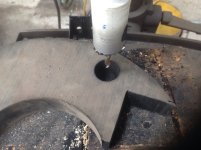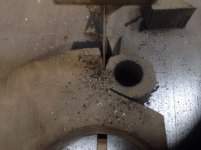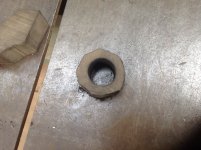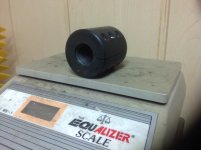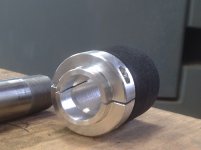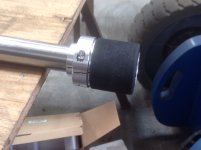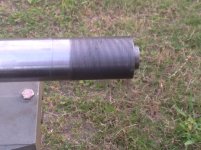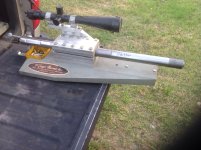Simple question, simple answer.....more or less.
Go ahead with whatever load workup, seating depth etc. I would probably suggest you thread for the tuner, but that really is optional. Once you are satisfied that your load is the best for that barrel, screw on the tuner. I prefer to start with it in as far as it will go and then back off two full turns. This give you plenty of working space, although in truth you will only need about 1/4 turn at most. You could start with it all the way out and two turns in. (I'm thinking Mike prefers it that way.) The fact is, either one will work. Next fire a three shot group as a base line. If the group has no vertical, lock it down you are there. But most of us like to tinker, so turn the tuner, either way, 1/16". Fire another three shot group. It should be slightly larger or slightly smaller. If it's larger go the other way, past you original mark 1/16" and fire another 3 shots. If it's smaller, either stop there (no vertical) or move another 1/16". It won't take long, if you have a good barrel, to reduce the vertical to "0". You can stop or do a couple more groups to confirm. This is simple stuff, don't overthink it. Make VERY small adjustments. That's all there is to it.
Rick
I agree with the last part, Rick..about keeping adjustments small and not over complicating this. Other than that, we should talk.
I start with my tuner on, during load development..BUT, I don't touch it until I settle on a load. I know what you are stating has been said many times on the various forums and that it can work, but why would I work up a load and then add something that essentially changes the barrel contour? That makes no sense to me. It does make sense to develop the load with it on but adjusting it while tuning with powder charge and seating depth methods is simply changing two things at once and it's much simpler to change one thing at a time and not chase your tail.
With my tuner, I run it all the way in then back it off 1/2 to a full turn...wherever a number you like pops up top...I like the number zero. My tuners are not designed to be, nor should they be "locked down". There are nylon tipped set screws that do set the tension against turning but allow adjustment without tools or damaging the threads on the barrel, with proper tension. This is as simple as running them in until they touch plus 1/4 to 3/8 of a turn on each of the three set screws.
The nylon tipped set screws not only set tension and allow for adjustment without tools, but they also load the threads, taking up for necessary clearance....A zero clearance thread is called "galled". They also dampen high frequency vibration, that is inevitable at a joint, short of a welded one.
Lastly, the nylon tipped set screws ride on the threads of the barrel. Behind those threads is a flat or journal machined on the barrel that an o-ring inside the rear of the tuner rides on. This, along with the 3 set screws, gives a total of 4 points of support along 1-1/2" of threads and o-ring journal...making for a well supported devise that doesn't move, is easily adjusted and is both repeatable and consistent.
They use a 32 tpi thread pitch count and have 32 marks on the tuner. This equates to almost exactly .001" of tuner travel per mark on the tuner. 1/16 of a turn is equivalent to 2 marks on the tuner. Once set, this would be equal to the largest tuner adjustment I have ever made on my tuner during a match, due to condition changes throughout the course of a day. You were probably there...at Somerset, a few years ago now, when the temp started out very cold and went up 45° during the day. So, that's 2 marks on my tuner over a 45° temp swing. That's the most I have ever had to move my tuner at any match since I started making them, a few years ago, now. Point being, 1/16 of a turn is a huge adjustment for only a conditional change in tune.
If you read my posts over the last few years, you'll find that I often state that there are 4 marks, on a typical short range BR contour barrel, between completely in tune to completely out of tune. Over hundreds of these tuners now, this has proven to be very, very predictable. The 4 marks vs 2 marks is based on the fact that while the tuner can be out as far as 4 marks, I have never seen it that far out from conditional changes alone.
In reality, once set, I don't think you should ever see the need to move more than two marks for condition changes, or 4 marks for any other changes, such as a totally different load or just starting out with a new tuner install.
Yes, I know this flies in the face of what some say. I do not base my findings on anything I have read or heard. Rather, what I have proven to myself to be true without doubt. The only exception to this has been a small one. That being, there seems to be as many as 6 marks from completely in, to completely out of tune on some of the long 1.250 straight contours used mostly in long range.
I promise you...everything I have just posted is way beyond anecdotal. It's remarkably consistent! Even across a wide range of contours, guns, calibers..everything centerfire, so far. Rimfire and air rifle are even only slightly different, but still very consistent in their own right.
I'd like to talk more with you about it in person when we see each other...and you're not running wide open.
I can even predict group size and shape and correlate it to tuner setting, now. It sounds complicated...but it's really not at all. It just couldn't be much easier. Maybe we can both get a little time to meet and shoot one day soon.
p.s. --Curious---I hope this post answers many questions that you have sent to me by email that I have had too little time to answer. --Mike


